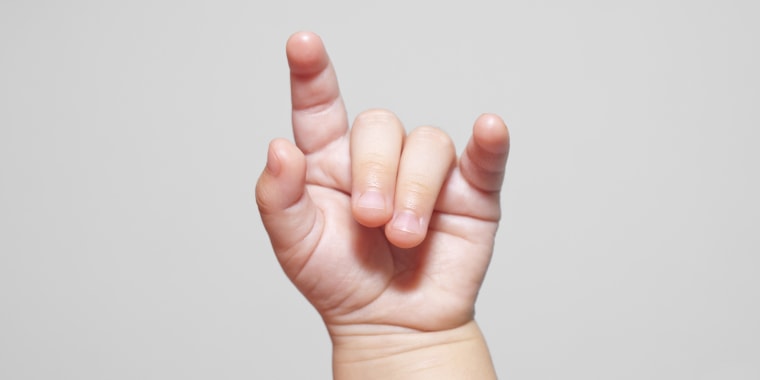Many new parents can relate to the frustration of trying to figure out the exact needs of their baby. Are they hungry? Do they need changed? Whether it's a piercing wail to have their diaper checked, or a cry out of hunger, parents are often limited until a baby speaks their first words. The answer? Baby sign language.
Baby sign language is a method of teaching simple gestures to children for the things they need and suddenly — a whole new world may open up for both babies and adults.
Lane Rebelo, baby sign language instructor and founder of Tiny Signs tells TODAY what parents (and parents-to-be) interested in baby sign language need to know before beginning their baby communication journey.
“A baby’s ability to speak develops later than his or her ability to comprehend spoken language, causing a lag between what they understand (receptive language) and what they can communicate (expressive language),” Rebelo tells TODAY.com
For some parents, baby sign language is a peek into the mind of their child, and an opportunity to begin connecting before speech is developed.
“Signing gives babies more refined tools than just pointing to express what they’re thinking," Rebelo says. “Parents who use sign language end up finding their little ones understand so much more than they ever would have imagined once they get started.”
How to teach baby sign language
The first step for teaching your baby sign language is to say the word and make the gesture at the same time. For example, when you hand your baby milk, say “milk” while making the sign for it (an open and closed fist/milking gesture).
Pair the sign with word every time you say it — remember, repetition is key. Don’t be discouraged if your baby doesn’t gesture for her milk right away. It may take her some time to get the hang of it. But when she does, suddenly the level of communication between you two will expand.
“Most families begin with useful and practical signs like ‘milk,’ ‘eat,’ ‘more’ and ‘all done’ when they first get started,” Rebelo says. “I recommend that parents also include some playful signs like ‘dog,’ ‘cat,’ ‘ball’ and even ‘light’ as these signs are fun and motivating for babies. Babies want to communicate about what interests them, so many families find early success with these playful signs, which helps get the ball rolling.”
Parents can find opportunities to sign to their baby throughout the day, from mealtimes to walks in the park to just playing together at home. Give your baby an exposure to a variety of items that pair with the same gesture so she will understand that the sign she makes gets her what she wants.
When to start baby sign language
Typically, most babies can begin signing in the range of 8-12 months of age. Rebelo suggests that interested parents begin using sign language when their baby is 6-8 months old but says not to worry if your child is older since there isn’t a magical window that closes.
“Parents can start teaching sign language to their baby at any time,” she says. “Some parents start right away, and others wait until after their baby's first birthday when they realize it would be really helpful for their frustrated toddler!”
And just like with other milestones like rolling over, crawling, and even talking, the exact time when sign language will begin working will vary from baby to baby.
“Five months is the youngest I have seen personally,” Rebelo says. "Other babies may not begin to sign back until around the first birthday, but then their sign language may take off rapidly. Sometimes it just doesn't click until after they turn one, but then it happens rapidly. Remember that you are the expert on judging your baby’s readiness.
Are there drawbacks to baby sign language?
Many parents wonder if using baby sign language will make their little one a late talker, but the research indicates the opposite may be true.
“Learning baby sign language definitely does not delay speech development, in fact, the research indicates that babies exposed to sign language speak earlier and have larger vocabularies,” Rebelo tells TODAY.com.
A seminal study by doctors Linda Acredolo and Susan Goodwyn, funded by the National Institute of Health, showed that 11-month old babies exposed to sign language had larger vocabularies and understood more words by age two than those in the non-signing group of the study.
So will your baby be signing even when she begins to talk?
“Most babies will sign exclusively at first, and then they might overlap speech with the sign and then the sign falls away as speech takes off,” Rebelo says. “Some babies skip the overlapping stage of signing and talking and will drop signing abruptly as their speech develops, which happens rapidly from about 18 months on for typically developing children.”
Related video:
